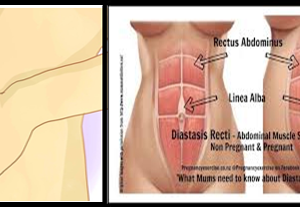DIASTASIS RECTI - Signs and Treatment

Diastasis Recti (abdominal separation) in pregnant and post partum women: Signs and Treatment
For some women, pregnancy can cause abdominal separation also called diastasis recti.
It is a condition where the right and left sides of the rectus abdominals, the so called ‘six-pack’ muscles, spread apart at the stomach midline (the linea alba).
During pregnancy, your abdominal muscles will separate, due to the growth of the baby in the uterus pushing against the abdominal wall, and pregnancy hormones that soften connective tissue.
Separation can occur any time in the last trimester but is most problematic after pregnancy when the abdominal wall is weak. If your abdominal muscles remain weak, you are more likely to suffer from back pain and have an increased risk of a hernia.
CAUSES OF DIASTASIS RECTI :
- A large baby
- With multiple births, for example, twins
- For those with a narrow pelvis
- For those with weak Abdominal muscles
- Due to the disruption of intersegmental and intrapelvic fascial tension of transverse abdominus muscle.
- For those with poor posture
- For those who have had previous complicated child births.
ASSESSMENT OF DIASTASIS RECTI DURING PREGNANCY :
Take a look at your abdomen. If you have a vertical prominent piece of tissue (like a crest or a ridge) which begins just below your sternum (which is the breastbone) and continues, in most cases, until the umbilicus, this might be the first sign of this condition.
- If this ridge is more visible when you are stretching your abdominal muscles than it is very probable that you have diastasis recti.
- When your abdomen is relaxed, and your muscles are not contracted, you may not see any signs of this condition.
ASSESSMENT OF DIASTASIS RECTI AFTER PREGNANCY :
Abdominal Separation/Diastasis Recti Test :
Lie on your back with your knees bent, and the soles of your feet on the floor. Place one hand behind your head, and the other hand on your abdomen, with your fingertips across your midline—parallel with your waistline— at the level of your belly button.
With your abdominal wall relaxed, gently press your fingertips into your abdomen. Roll your upper body off the floor into a “crunch,” making sure that your ribcage moves closer to your pelvis.
Move your fingertips back and forth across your midline, feeling for the right and left sides of your Rectus Abdominis muscle.
SIGNS OF ABDOMINAL SEPARATION/DIASTASIS RECTI:
A small amount of separation of midline—one to two fingers’ width—is common after most pregnancies, and is not a problem.
But if the gap at your midline is:
- More than 2 1/2 finger widths
- Soes not shrink as you deepen the work of your abdominals
- You can see a small mound protruding at your midline then you probably have abdominal separation/diastasis recti and need to take a few special precautions during exercise and other activities.
TREATMENT OF DIASTASIS RECTI :
- Kegel’s exercises.
- Breathing exercises focusing mainly on inverted breathing (only postpartum) and lateral costal breathing.
- Progressive Care strengthening exercises.
- Body mechanics correction
- Postural awareness program
- Necessary precautions
ABDOMINAL BINDERS
Binders do have a place in the treatment of the condition, but the wrong or overuse of them can cause more problems.
It is best not to use an abdominal binder unless absolutely necessary, for example during pregnancy in the third trimester and 6 weeks after delivery if there is a separation of 2 fingers or more
BELLY BAND
Wearing a belly band during pregnancy (one made specifically for pregnant women) will help increase proprioception and muscle awareness. A belly band or tight tube top can be used after childbirth for the same reasons.
KEY POINTS FOR DIASTASIS RECTI EXERCISES
Appropriate diastasis recti exercises can restore deep abdominal control and promote abdominal muscle recovery after pregnancy and childbirth.
The key to successful strengthening is to ensure the correct deep abdominal activation technique and then progressively challenge the deep abdominal muscles with exercises that further promote core control.
It is vital that women with diastasis recti avoid intense core abdominal exercises.
Check out these links for relevant information: Women’s health, Ante natal post natal
For more details contact
us on 📞9618906780
